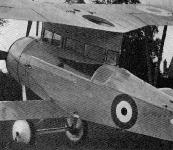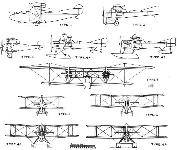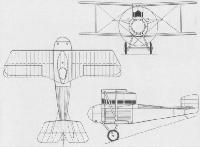P.Lewis The British Fighter since 1912 (Putnam)
Clifford Tinson, late of Bristol and the Admiralty’s Air Department, was engaged by Sage and Company at the beginning of 1916 as Chief Designer. His first design for the firm was a two-seat biplane fighter with a wing span of only 22 ft. 2-5 in. and arranged so that the gunner received an unrestricted field of fire by standing to fire his Lewis gun through 360 above the upper wings. The engine was the 100 h.p. Monosoupape Gnome in a neat cowling, and a glazed cabin enclosed the crew and supported the upper planes. After flying for the first time on 10th August, 1916, the Sage Type 2 crashed on the 20th of the following month at Cranwell. The design was then abandoned as the style of armament installation had been rendered unnecessary by the advent of the synchronizer gear.
Показать полностью
F.Mason The British Fighter since 1912 (Putnam)
Sage Type 2
Another long-established woodworking company which entered the aircraft industry by means of sub-contract manufacture was Frederick Sage of Peterborough. After engaging in airship component production for the Admiralty, followed by contracts to produce Short 184 seaplanes in 1915, Sage secured the services of Eric Cecil Gordon England, one of Britain’s pioneer airmen (Royal Aero Club Certificate No 68), who was appointed head of the company’s aeronautical department. In January 1916 he was joined by Clifford Wilfrid Tinson, formerly of Bristols and the Admiralty’s Air Department, to become Chief Designer; he took over the design of a new two-seat fighter, the Sage Type 2 (the Type 1 had been an unbuilt bomber project).
The Sage 2 represented a novel approach to a familiar problem, that of mounting a gun to fire directly forward past a tractor propeller. It has been shown that, apart from the ultimate solution provided by gun interrupter gear, several companies had pursued designs that incorporated gunners’ nacelles which tended to be fairly large and imposed substantial drag. Tinson’s design incorporated an enclosed cabin, accommodating both pilot and gunner, its superstructure occupying the entire depth of the wing gap between fuselage and upper wing, so that the gunner could stand with his head and shoulders above the wing. In the absence of a gun ring, he was provided with two spigots on which could be mounted a Lewis gun with arcs of fire both forward and aft.
With a wing span of only 22 feet, the Type 2 was an extraordinarily compact and clean design and, added to the fact that it was powered by a beautifully cowled 100hp Gnome monosoupape, its performance was outstanding for an armed two-seater. Construction was very simple, the fuselage being a wooden box-girder, faired by formers and stringers with curved upper decking; the wing gap was fairly large, and the only wing struts were a pair of V interplane members. The cabin superstructure replaced the customary cabane struts and was of excellent aerodynamic cross-section. Tinson’s former association with Frank Barnwell was evident in the Sage’s balanced rudder, which was identical to that of the Bristol Scout; as on the Scout, there was no fixed vertical fin.
First flown on 10 August 1916, the Sage at once demonstrated its remarkable performance by recording a maximum speed of 112 mph at sea level, but its flying was shortlived. During a test flight at Cranwell on 20 September, its sternpost failed, and in an attempted landing the aircraft struck a tree and was destroyed. Although by then the front gun interrupter gear had been accepted as reliable in service, the Sage would have represented an excellent two-seat escort fighter; however, the Admiralty had no such requirement, and further development was abandoned.
Type: Single-engine, two-seat, single-bay biplane fighter.
Manufacturer: Frederick Sage & Co Ltd, Peterborough.
Powerplant: One 100hp Gnome monosoupape engine driving four-blade propeller.
Structure: All-wooden construction with ply and fabric covering.
Dimensions: Span, 22ft 2 1/2 in; length, 21ft 1 5/8 in; height, 9ft 6in; wing area, 168 sq ft.
Weights: Tare, 890lb; all-up, 1,546lb.
Performance: Max speed, 112 mph at sea level; climb to 10,000ft, 6 min 30 sec; service ceiling, 16,000ft; endurance, 2 1/2 hr.
Armament: One 0.303in Lewis machine gun on fore or aft spigot mountings on upper wing fired by gunner standing in cabane superstructure.
Prototype: One, not allotted serial number (first flown 10 August 1916; crashed 20 September 1916). No production.
Показать полностью
W.Green, G.Swanborough The Complete Book of Fighters
SAGE TYPE 2 UK
Designed by Clifford W Tinson for Frederick Sage & Company, the Type 2 two-seat fighting scout was of original concept. Considerable care was taken to reduce aerodynamic drag, the 100 hp Gnome Monosoupape nine-cylinder rotary engine being fully cowled, a large propeller spinner being provided and the crew being accommodated in a fully-glazed cabin. Of conventional wire-braced wooden construction, the Type 2 was a single-bay biplane with considerable gap, the upper wing being supported by the cabin structure and having an aperture above the observer’s seat. When standing to fire his 0.303-in (7,7-mm) machine gun, the observer had a wide and clear field of fire. Remarkably small, the Type 2 had rod-activated ailerons in the upper wing only. First flown on 10 August 1916, it proved to possess a very good performance, but gun synchronization had meanwhile become available, and after the sole prototype had been wrecked in a forced landing on 20 September 1916, no attempt was made to rebuild the aircraft or develop it.
Max speed, 112 mph (180 km/h) at sea level.
Time to 10,000 ft (3 050 m), 14.75 min.
Endurance, 2.5 hrs.
Empty weight, 890 lb (404 kg).
Loaded weight, 1,546 lb (701 kg).
Span, 22 ft 2 1/2 in (6,77 m).
Length, 21 ft 1 5/8 in (6,45 m).
Height, 9 ft 6 in (2,89 m).
Wing area, 168 sq ft (15,61 m2).
Показать полностью
J.Bruce British Aeroplanes 1914-1918 (Putnam)
Sage Type 2
<...>
The Sage Type 1 was never completed, but early in 1916 work began on the Type 2. The new machine was designed by Clifford W. Tinson, who had left the Air Department of the Admiralty to join Sages as their Chief Designer in January, 1916.
The Sage Type 2 was an attempt to produce an effective fighting aeroplane in the absence of a machine-gun interrupter gear. It was a remarkably small two-seat biplane of strikingly unusual appearance. The aeroplane was more or less designed around the observer’s gun, and emphasis was laid upon a wide and clear field of fire. To this end the observer, who occupied the rear seat, stood up with his head through the upper wing.
The arrangement was not unique. The French Nieuport 10 and the Austrian Lloyd biplane 40.05 of 1915 had similar firing positions for their front-seat observers; in the latter case a large, ugly fairing encased the observer’s body and filled the gap between fuselage and upper wing, incidentally depriving the pilot of any forward view. In 1916 two other Austrian aircraft had built-up over-wing positions for their back-seat observers: they were the Ufag-built Brandenburg C.I 64.01 and the Phonix-built Brandenburg C.I 26.17, but only the latter machine provided an enclosure for the pilot also.
On the Sage Type 2 a glazed cabin enclosed both members of the crew and filled the gap between the fuselage and the upper wing. Structurally the machine was typical of its period, and was a wire-braced wooden airframe. Considerable attention was paid to the reduction of drag: the 100 h.p. Gnome Monosoupape rotary engine was remarkably closely cowled, and a large spinner was fitted to the four-bladed airscrew. The single-bay wings were of unequal chord, and were interconnected by vee interplane struts: the nose portion of each wing was covered with plywood. Ailerons were fitted to the upper wing only, and were actuated by spanwise rods which ran along the rear side of the rear spar wholly within the wing. The outline of the rudder was reminiscent of that of the Bristol Scout, on which Mr Tinson had worked when he was with the British and Colonial Aeroplane Co. There was no fin.
The Sage Type 2 made its first flight on August 10th, 1916, and established performance figures which were exceptionally good for a two-seater with a maximum power of 105 h.p. It did not long survive, however, for in the course of a test flight at Cranwell on September 20th, 1916, the rudderpost failed. The aircraft became uncontrollable and, in attempting to land, it ran into a tree and was wrecked.
No attempt was made to develop the design, for practical interrupter gears had become available some months before the appearance of the Sage Type 2.
SPECIFICATION
Manufacturers: Frederick Sage & Co., Ltd., Peterborough.
Power: 100 h.p. Gnome Monosoupape.
Dimensions: Span: 22 ft 2 1/2 in. Length: 21 ft 1 5/8 in. Height: 9 ft 6 in. Chord: upper 5 ft, lower 2 ft 8 in. Gap:
5 ft 6 in. Dihedral: 2. Incidence: upper 5, lower 3. Span of tail: 9 ft 5 in. Airscrew diameter: 8 ft.
Areas: Wings: upper 100 sq ft, lower 68 sq ft, total 168 sq ft. Ailerons: each 12-5 sq ft, total 25 sq ft. Tailplane: 20 sq ft. Elevators: 14-5 sq ft. Rudder: 9 sq ft.
Weights: Empty: 890 lb. Loaded: 1,546 lb.
Performance: Maximum speed at ground level: 112 m.p.h.; at 10,000 ft: 109-75 m.p.h.; at 15,000 ft: 104 m.p.h.
Climb to 5,000 ft: 6 min 30 sec; to 10,000 ft: 14 min 45 sec; to 15,000 ft: 35 min. Ceiling: 16,000 ft. Endurance: 2 1/2 hours.
Tankage: Petrol: 27 1/2 gallons. Oil: 8 gallons.
Armament: One Lewis machine-gun mounted above the upper wing and fired by the observer.
Показать полностью
H.King Armament of British Aircraft (Putnam)
Sage
Type 2. The uncompleted Sage Type I of 1916 was a twin-engined bomber with nose, upper and floor guns; the Type 2 of the same year was a two-seat single-engined fighter, the design of which represented one of many attempts to surmount the difficulties which persisted until gun synchronizing gears became available. They were, in fact, already becoming available as the aircraft was constructed. The layout adopted resembled one that had been schemed by the Short company, the gunner standing largely in a faired superstructure between the fuselage and top wing, the upper surface of which was cut away to permit the use of a Lewis gun. The pilot, who was unarmed, sat, wholly enclosed, at the forward end of the superstructure.
Показать полностью
Jane's All The World Aircraft 1919
The Sage No. 2 Two-seater fighter was designed in the spring of 1916. The pilots and observers seats are enclosed in a Streamline cabin reaching to the upper plane, the top plane being left open so as to enable the observer to use a Lewis gun in a ring mounting on the top plane, for firing over the propeller.
Specification.
Type of machine Biplane.
Name or type No. of machine Scout.
Purpose for which Intended Fighting.
Span 32 ft. 2 1/2 In.
Sap, maximum and minimum 5 ft. 6 in.
Overall length 21 ft. 1 5/8 In.
Maximum height 9 ft. 6 in.
Chord Top plane, 5 ft.;
lower plane 2 ft. 8 in.
Total surface of wings 168 sq. ft.
Span of tail 9 ft. 5 In.
Total area of tail 20 sq. ft.
Area of elevators 14.5 sq. ft.
Area of rudder 9 sq. ft.
Area of each aileron 12 1/2 sq. ft.
Total area of ailerons 25 sq. ft.
Maximum cross section of body 3 ft. 5 in. dia.
Horizontal area of body 44 sq. ft.
Vertical area of body 52.5 sq. ft.
Engine type and h.p. 100 h.p. Gnome.
Airscrew diameter and pitch 8 ft. d. x 7 ft. p.
Airscrew revs 1200 r.p.m.
Weight of machine empty 890 lbs.
Load per sq. ft. 9.2 lbs.
Weight per h.p. 15.46 lbs.
Tank capacity in hours 2 1/2 hours.
Tank capacity in gallons 26 gallons.
Performance.
Speed low down 112 m.p.h.
Speed at 10,000 feet 100 m.p.h.
Landing speed 50 m.p.h.
Climb.
To 5,000 feet 6 1/2 minutes.
To 10,000 feet 14 3/4 minutes.
Disposable load apart from fuel 96 lbs.
Total weight of machine loaded 1546 lbs.
Ceiling 16,000 ft.
Показать полностью
Журнал Flight
Flight, July 24, 1919.
"MILESTONES"
THE SAGE MACHINES
The Sage Scout, Type 2 (1916)
Before synchronised gun-gears became generally adopted the tractor type of machine was of comparatively little use as a fighter, in spite of its inherent advantage over the pusher type as regards performance. In order to overcome the difficulty the Sage Type 2 was designed. As already mentioned, when this machine was first conceived, the synchronized gun had not become generally accepted, there being at the time, not unnaturally, a certain doubt as to the feasibility of devising a mechanism which would prevent the gun from being fired while a screw blade was in line with it. We say not unnaturally because on the face of it the problem of designing such a gear is a serious one, considering the speed of revolution of the screw and the rate of firing of the gun. However, at the time Sage No. 2 was conceived this problem was still being tackled, and so instead of experimenting with gun gears this firm turned their attention to the design of a machine which should mount its gun in such a position as to provide a free field of fire. It may be remembered that quite early in the War the French Nieuport firm produced a little two-seater in which the observer could stand upright with his head and shoulders projecting through a circular opening in the top plane. This was more or less the type adopted by the designer of Sage No. 2, but realizing the discomfort caused to the gunner by standing upright in the slipstream of the propeller, and the effect this draught would have on the gunner's sighting, provisions were made for sheltering the gunner inside an enclosed cabin. How this was accomplished will be seen from the accompanying illustrations.
The Type 2 is a small machine, and may be said to belong to the scout class as regards dimensions, although it is designed as a two-seater. The upper plane is of greater span and chord than is the bottom one, and the inter-plane struts are of the Vee type, with but one pair on each side. The top plane, it will be seen, has its centre section mounted on and forming the roof of a streamline structure enclosing the heads and shoulders of pilot and gunner. When standing up in his cockpit the gunner can just see over the top of the top plane, where his gun is mounted. He thus has an uninterrupted field of vision extending through the whole of an upper hemisphere. It will no doubt have been noticed that the gap of the Sage Type 2 appears to be greater than is called for by aerodynamical reasons. This is occasioned by the desire on the part of the designer to provide the gunner with a free field in a forward direction also. This - without some form of synchronised gear - was only possible by placing the gun so high that it would fire over the tips of the propeller.
It is interesting to note that in spite of the large amounts of side area presented by this cabin the machine was, we are informed, quite easy to handle and appeared to be reasonably stable. During a trial flight the rudder post gave way, with the result that the machine became unmanageable and in landing it crashed into a tree with somewhat serious results to its wings. It was not, we think, perpetuated, probably because by then the synchronised gun-gears had been found to work well in practice.
Показать полностью










